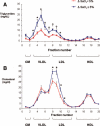Dyslipidemia and atherosclerosis induced by chronic intermittent hypoxia are attenuated by deficiency of stearoyl coenzyme A desaturase
- PMID: 18832746
- PMCID: PMC2658638
- DOI: 10.1161/CIRCRESAHA.108.178533
Dyslipidemia and atherosclerosis induced by chronic intermittent hypoxia are attenuated by deficiency of stearoyl coenzyme A desaturase
Abstract
Obstructive sleep apnea leads to chronic intermittent hypoxia (CIH) and is associated with atherosclerosis. We have previously shown that C57BL/6J mice exposed to CIH and a high-cholesterol diet develop dyslipidemia, atherosclerosis of the aorta, and upregulation of a hepatic enzyme of lipoprotein secretion, stearoyl coenzyme A desaturase 1 (SCD-1). We hypothesized that (1) SCD-1 deficiency will prevent dyslipidemia and atherosclerosis during CIH; and (2) human OSA is associated with dyslipidemia and upregulation of hepatic SCD. C57BL/6J mice were exposed to CIH or normoxia for 10 weeks while being treated with either SCD-1 or control antisense oligonucleotides. Obese human subjects underwent sleep study and bariatric surgery with intraoperative liver biopsy. In mice, hypoxia increased hepatic SCD-1 and plasma very-low-density lipoprotein cholesterol levels and induced atherosclerosis lesions in the ascending aorta (the cross-section area of 156514+/-57408 microm(2)), and descending aorta (7.0+/-1.2% of the total aortic surface). In mice exposed to CIH and treated with SCD-1 antisense oligonucleotides, dyslipidemia and atherosclerosis in the ascending aorta were abolished, whereas lesions in the descending aorta showed 56% reduction. None of the mice exposed to normoxia developed atherosclerosis. In human subjects, hepatic SCD mRNA levels correlated with the degree of nocturnal hypoxemia (r=0.68, P=0.001). Patients exhibiting oxyhemoglobin desaturations at night showed higher plasma triglyceride and low-density lipoprotein cholesterol levels, compared to subjects without hypoxemia. In conclusion, CIH is associated with dyslipidemia and overexpression of hepatic SCD in both humans and mice alike; SCD-1 deficiency attenuates CIH-induced dyslipidemia and atherosclerosis in mice.
Figures






References
-
- Gastaut H, Tassinari CA, Duron B. Polygraphic study of the episodic diurnal and nocturnal (hypnic and respiratory) manifestations of the Pickwick syndrome. Brain Res. 1966;1:167–186. - PubMed
-
- Punjabi NM, Sorkin JD, Katzel LI, Goldberg AP, Schwartz AR, Smith PL. Sleep-disordered breathing and insulin resistance in middle-aged and overweight men. Am J Respir Crit Care Med. 2002;165:677–682. - PubMed
-
- Young T, Palta M, Dempsey J, Skatrud J, Weber S, Badr S. The occurrence of sleep-disordered breathing among middle-aged adults. N Engl J Med. 1993;328:1230–1235. - PubMed
-
- Marin JM, Carrizo SJ, Vicente E, Agusti AG. Long-term cardiovascular outcomes in men with obstructive sleep apnoea-hypopnoea with or without treatment with continuous positive airway pressure: an observational study. Lancet. 2005;365:1046–1053. - PubMed
-
- Shahar E, Whitney CW, Redline S, Lee ET, Newman AB, Javier NF, O'Connor GT, Boland LL, Schwartz JE, Samet JM. Sleep-disordered breathing and cardiovascular disease: cross-sectional results of the Sleep Heart Health Study. Am J Respir Crit Care Med. 2001;163:19–25. - PubMed
Publication types
MeSH terms
Substances
Grants and funding
LinkOut - more resources
Full Text Sources
Medical
Molecular Biology Databases

